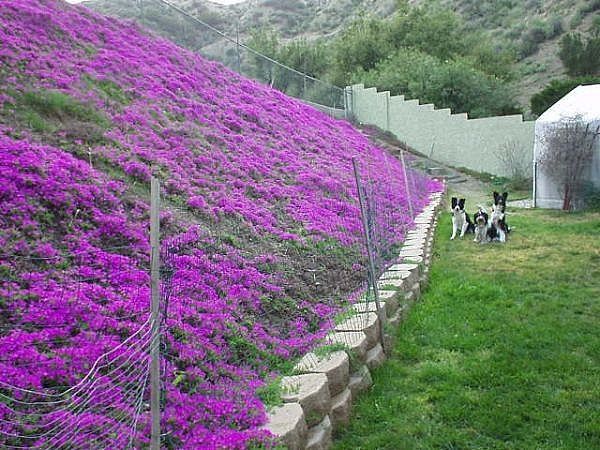Choosing the best ground cover plants for slopes and hillsides can be challenging. Some ground covers will wash away almost as fast as you plant them. There are a lot of ground cover plants that grow quickly and can handle heavy rain, even in garden areas that slope.
One good thing about growing a ground cover that grows quickly is that the roots will stay put better if they can strengthen them quickly. There are many ground covers that look great with other plants, so you can make your garden look like a beautiful hillside.
You’ve come to the right place if you’ve had trouble finding the right plant for your garden’s hilly spots. There are many ground covers that grow quickly and can take hold in gardens with a sloped surface. Please find below a complete list of ground covers that will grow quickly and make any sloped garden area more interesting to look at. Ready to learn more? Let’s dig in!.
Groundcovers are an excellent erosion control solution for sloped areas. Their dense spreading foliage stabilizes the soil to prevent washouts. Follow these best practices when planting groundcover on hills and slopes:
1. Remove Existing Vegetation
Eliminate turf grass, weeds, and other existing plants first This prevents competition and gives groundcover the best chance to establish Herbicides, solarization, or smothering with mulch can remove vegetation.
2. Loosen Compacted Soil
Use a mattock or digging fork to gently loosen compacted soil and improve drainage before planting Avoid tilling slopes, which worsens erosion.
3. Amend Soil
Work 2-3 inches of compost into the top 6 inches of soil to enrich nutrition and moisture retention. Compost also encourages beneficial microbial activity.
4. Retain Topsoil
When digging holes, keep removed topsoil and replace it after planting. Don’t mix subsoil into the hole, which reduces fertility.
5. Space Plants Properly
Check recommended on-center spacing for the groundcover variety. Place temporarily with flags or flour to preview layout before digging holes.
6. Dig Proper Holes
Dig planting holes no deeper than the root ball but 2 times wider. On slopes, dig holes parallel to the slope, not perpendicular.
7. Set Plant Crowns High
Position plants so the top of the root ball sits 1-2 inches above grade. This prevents burial from soil settling after watering.
8. Backfill with Potting Mix
Fill holes with potting soil to avoid air pockets around roots. Water-in well to settle the soil.
9. Mulch Carefully
Mulch conserves moisture and suppresses weeds but too much can smother plants. Limit to 1-2 inches maximum on slopes.
10. Water Thoroughly
Proper watering is key, especially the first season. Plan to water new plantings daily or as needed to keep soil moist but not soggy.
When planting groundcovers on slopes, good soil preparation and careful planting technique leads to success. Space plants properly for full coverage. Set crowns high to allow for settling. Water deeply and often until plants establish extensive root systems. With time and proper care, groundcovers will stabilize and beautify steep slopes.
For severely eroded slopes, additional stabilization like geotextiles, retaining walls, or terracing may be needed along with groundcovers. Consult with a professional landscaper for the best solutions for your site. The investment of time and care when planting will allow your new groundcover to quickly establish and prevent costly erosion problems.
10 Best Plants for Slopes, Hillsides and Banks in Your Garden Garden Trends
FAQ
What month is best to plant ground cover?
What is the fastest growing ground cover?
What is the best plant to plant on a slope?
How do you plant ground cover on a steep slope?
Before planting ground cover on a steep slope, it’s important to prepare the soil. First, banish any existing weeds by pulling them out or spraying them with an herbicide. Next, loosen the soil on flat areas by tilling or turning it with a shovel to a depth of six inches. Then, apply all-purpose, time-released fertilizer per package directions.
What is a good groundcover for a slope?
The candytuft grows quickly and is one of the best groundcover plants for a slope. This vigorous plant is a drought-tolerant ground cover and will grow in poor soil—plant in full sun. Daylilies grow quickly and are a showy perennial groundcover when planted en-mass.
How to plant a ground cover on a slope & embankment?
Use mulch: Mulch is essential when planting ground covers on slopes and embankments. It helps to retain moisture in the soil and prevent erosion. Use a layer of organic mulch such as wood chips or bark to cover the soil between the plants.
How do I choose a sloping ground cover?
Slopes can be challenging areas to find plants for in your garden. Without the proper ground covers, hillsides or sloping garden areas can suffer from erosion. Before choosing a quick spreading ground cover, test your soil. Also, take note of the shade in the area you plan to cover.
- The Ultimate Guide to Growing Strawberries in Raised Beds - August 8, 2025
- No-Dig Garden Beds: The Easiest Way to Grow a Beautiful Garden - August 6, 2025
- How to Protect and Preserve Wood for Raised Garden Beds - August 6, 2025

